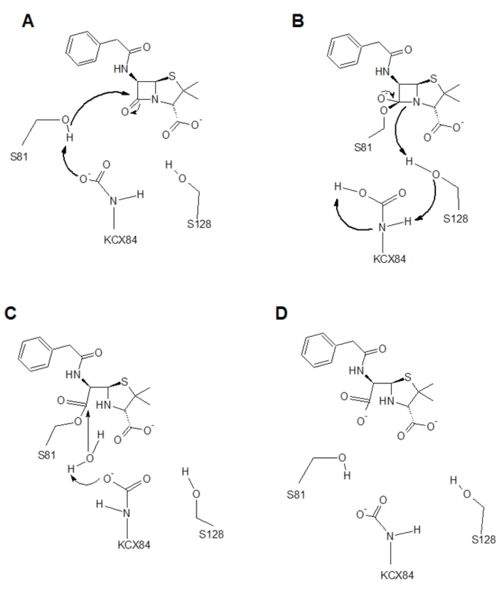Sandbox Reserved 994
From Proteopedia
(Difference between revisions)
| Line 27: | Line 27: | ||
| - | There are three catalytic residues involved in the hydrolysis of β-lactam antibiotics. Serine-81 is the catalytic serine, which performs a nucleophilic attack on the β-lactam ring after being deprotonated by the carboxylated lysine-84 (KCX84). This carboxylated lysine is formed by CO2 in the environment engaging in unfavorable interactions with the hydrophobic pocket of OXA-24, so it carboxylates Lysine-84 (A). | + | There are three catalytic residues involved in the hydrolysis of β-lactam antibiotics. Serine-81 is the catalytic serine, which performs a nucleophilic attack on the β-lactam ring after being deprotonated by the carboxylated lysine-84 (KCX84). This carboxylated lysine is formed by CO2 in the environment engaging in unfavorable interactions with the hydrophobic pocket of OXA-24, so it carboxylates Lysine-84 (A).<ref name="Leonard" /> |
| - | The second step (B) forms a high energy intermediate. The cyclic amide from the β-lactam deprotonates Serine-128 (S128), which proceeds to deprotonate the amine on KCX84, which deprotonates the carboxylate group. This high energy intermediate resolves to form the stable acyl-enzyme intermediate. | + | The second step (B) forms a high energy intermediate. The cyclic amide from the β-lactam deprotonates Serine-128 (S128), which proceeds to deprotonate the amine on KCX84, which deprotonates the carboxylate group. This high energy intermediate resolves to form the stable acyl-enzyme intermediate.<ref name="Leonard" /> |
| - | The third step (C) proceeds with the use of a catalytic water, which is deprotonated by KCX84. The water now can mount a nucleophilic attack on the ester linkage connecting S81 and the hydrolyzed β-lactam. This forms a high energy dissociation intermediate, where S81 is released by a mechanism, which has not quite yet been determined. It is suspected that it deprotonates KCX84, but this has not yet been confirmed. | + | The third step (C) proceeds with the use of a catalytic water, which is deprotonated by KCX84. The water now can mount a nucleophilic attack on the ester linkage connecting S81 and the hydrolyzed β-lactam. This forms a high energy dissociation intermediate, where S81 is released by a mechanism, which has not quite yet been determined. It is suspected that it deprotonates KCX84, but this has not yet been confirmed.<ref name="Leonard" /> |
| - | In step four (D), The enzyme is successfully regenerated and the hydrolyzed β-lactam antibiotic is released back into solution. OXA-24 is now free to hydrolyze another substrate and the antibiotic has been rendered useless. | + | In step four (D), The enzyme is successfully regenerated and the hydrolyzed β-lactam antibiotic is released back into solution. OXA-24 is now free to hydrolyze another substrate and the antibiotic has been rendered useless.<ref name="Leonard" /> |
This is a sample scene created with SAT to <scene name="/12/3456/Sample/1">color</scene> by Group, and another to make <scene name="/12/3456/Sample/2">a transparent representation</scene> of the protein. You can make your own scenes on SAT starting from scratch or loading and editing one of these sample scenes. | This is a sample scene created with SAT to <scene name="/12/3456/Sample/1">color</scene> by Group, and another to make <scene name="/12/3456/Sample/2">a transparent representation</scene> of the protein. You can make your own scenes on SAT starting from scratch or loading and editing one of these sample scenes. | ||
Revision as of 03:15, 26 February 2015
| This Sandbox is Reserved from 20/01/2015, through 30/04/2016 for use in the course "CHM 463" taught by Mary Karpen at the Grand Valley State University. This reservation includes Sandbox Reserved 987 through Sandbox Reserved 996. |
To get started:
More help: Help:Editing |
OXA-24 β-lactamase
| |||||||||||
References
- ↑ Hanson, R. M., Prilusky, J., Renjian, Z., Nakane, T. and Sussman, J. L. (2013), JSmol and the Next-Generation Web-Based Representation of 3D Molecular Structure as Applied to Proteopedia. Isr. J. Chem., 53:207-216. doi:http://dx.doi.org/10.1002/ijch.201300024
- ↑ Herraez A. Biomolecules in the computer: Jmol to the rescue. Biochem Mol Biol Educ. 2006 Jul;34(4):255-61. doi: 10.1002/bmb.2006.494034042644. PMID:21638687 doi:10.1002/bmb.2006.494034042644
- ↑ 3.0 3.1 3.2 3.3 3.4 Leonard DA, Bonomo RA, Powers RA. Class D beta-lactamases: a reappraisal after five decades. Acc Chem Res. 2013 Nov 19;46(11):2407-15. doi: 10.1021/ar300327a. Epub 2013 Jul, 31. PMID:23902256 doi:http://dx.doi.org/10.1021/ar300327a
- ↑ doi: https://dx.doi.org/10.3390/antibiotics3020128#sthash.iyPihLj1.dpuf
- ↑ PMCID: PMC162717
- ↑ Patrick, G. (2005). Antibacterial Agents. An Introduction to Medicinal Chemistry (3rd Ed), pages 388-414.
- ↑ Meroueh, S.O; Minasov, G; Lee, W; Shoichet, B.K; Mobashery, S. Structural aspects for evolution of beta-lactamases from penicillin-binding proteins. J. Am. Chem Soc. (2003), 125, 9612-9618.
- ↑ Neu, Harold. "The Crisis in Antibiotic Resistance." Science (1992) 257, 5073. ProQuest Medical Library: p. 1064-1072.
- ↑ Bush K, Jacoby GA. Updated functional classification of beta-lactamases. Antimicrob Agents Chemother. 2010 Mar;54(3):969-76. doi: 10.1128/AAC.01009-09., Epub 2009 Dec 7. PMID:19995920 doi:http://dx.doi.org/10.1128/AAC.01009-09
- ↑ Leonard DA, Bonomo RA, Powers RA. Class D beta-lactamases: a reappraisal after five decades. Acc Chem Res. 2013 Nov 19;46(11):2407-15. doi: 10.1021/ar300327a. Epub 2013 Jul, 31. PMID:23902256 doi:http://dx.doi.org/10.1021/ar300327a
- ↑ Bou G, Oliver A, Martinez-Beltran J. OXA-24, a novel class D beta-lactamase with carbapenemase activity in an Acinetobacter baumannii clinical strain. Antimicrob Agents Chemother. 2000 Jun;44(6):1556-61. PMID:10817708


